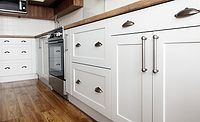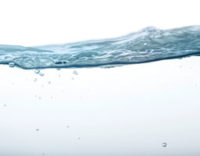New Generation of Waterborne UV-Curable Resins
- 1 pack waterborne acrylics and polyurethanes,
- 1 pack nitrocellulose based products,
- 1 and 2 pack acid curing lacquers (also in combination with nitrocellulose),
- 2 pack urethanes (based on alkyds or acrylics),
- 2 pack unsaturated polyesters and
- UV-curable resins.
UV-curable coatings are important in this field because of their excellent chemical resistance and fast curing times. The ecological aspect of formulating solvent-free lacquers with this technology is beneficial, as legislation for emissions of organic solvents becomes increasingly stringent.
Existing UV-curable systems fulfill many of the general demands of the wood coating market, including the following.
- Excellent reactivity (> 10 m/min/1 Hg lamp)
- High chemical resistance (DIN 68861, at least section 1B)
- Satisfactory flexibility
- Low yellowing effects (also good weatherability for outdoor applications)
- Early and good sandability
- Good stackability
- Different gloss grades
- Easy repairing of already coated surfaces
- Cold check stability
But two requests are very difficult to fulfill with these solventfree UV-lacquers.
First, many low-viscosity applications (especially spraying and vacuum techniques) are difficult. To reduce the viscosity to the desired level a high amount of reactive diluent(s) is necessary, which influences and changes the properties of the lacquer and results in dangerous aerosols during spraying applications because of the sensitization potential of most reactive diluents.
Open-core coatings with 100% material are quite impossible. Therefore, 10 years ago water was found to be one solution for reducing the content of nonvolatile matter and adjusting the viscosity to an appropriate application level without adding organic solvents or reactive diluents.
History of Waterborne UV-Curable Resins
First Generation: Externally Emulsified ProductsBy the addition of external (not incorporated into the polymer) surfactant (emulsifier) and high shear forces it was possible to render conventional UV-curable resins water dilutable. These emulsions have relatively high solids contents, but they are very sensitive against pH-value shifts and shear stress, such as during the grinding process.
Second Generation: Sterically (Nonionically) Stabilized Products
To avoid external emulsifiers, polyethylene glycol structures are incorporated into the polymers. Due to these permanent hydrophilic structures in the polymer backbones these types of products show very poor chemical resistance compared to conventional UV-resins.
Third Generation: Blends with Waterborne Dispersions
Blends of physically drying dispersions (in most cases: acrylic dispersions) with UV-curable, hydrophilic oligomers/polymers. The UV-curable component is stabilized in the aqueous phase by the non UV-curable acrylic dispersion.
Due to the low amount of curable compound in the whole system, the crosslinking density of such products is not very high and therefore the resistance against chemicals is not as high as with conventional UV products.
Fourth Generation: Self Emulsifying, Ionically Stabilized Dispersions
It is known that self emulsifying products can be made by integrating ionic groups into the polymer backbone, which render the whole polymer watersoluble after neutralization with the opposite ion. Such products have very good emulsion properties: they are very shear stable and due to their small particle sizes they have a very long shelf life.
Taking into account all basic requirements for UV-curable coatings in the wood markets listed above, we concluded that a polyurethane acrylate stabilized by carboxylic (anionic) groups that is neutralized with a base should be the best solution. Figure 1 shows the schematic structure of such a polymer.
By careful choice of the raw materials used, non-yellowing products for outdoor applications and physically drying types can be synthesized. The dispersions are very shear stable; also the freeze/thaw stability is excellent. Therefore, grinding of pigments for pigmented lacquers is possible in the resin and pigment pastes can be avoided.
With these new products, we checked out whether waterborne UV-curable products can bring some benefits for wood coatings based on this technology.
Comparison of the New Waterborne Products with Conventional (100% or Solventborne) UV-Curing Systems
Low Viscosity Applications With waterborne products, all kinds of low-viscosity applications (especially spraying) are possible. Viscosity adjustment can be done very easily with water without changing the properties of the coating, whereas a reduction of the lacquer viscosity with reactive diluents will change the properties from the polymer more to those of the reactive diluent(s). Such as with solventborne systems, a flash off step is necessary for the waterborne lacquer prior to the curing process.Reactivity, Chemical Resistance and Sandability
No big differences in reactivity (> 10 m/min/1 Hg lamp), chemical resistance (requirements of DIN 68861, 1B are met easily) and sandability could be detected. Comparison of different waterborne lab products revealed that the resistance (e.g., against acetone attack) is dependent on the polymer backbone and the crosslinking density of the polymer.
Matting and Abrasion Resistance
Interestingly, it was found that for the waterborne types only half the amount of matting agent was needed to achieve the same gloss grade compared to the 100% polyether acrylate.
Furthermore, the abrasion resistance of the new products seemed to start from a higher level that could be reached only by doing a lot of formulation work with the conventional types.
Adhesion and Elasticity
The most striking advantage of the new products over non-waterbornes is the excellent adhesion properties not only on wood, but also on metals and plastics. Due to the high average molecular weight of the polymer and the reduced crosslinking density, the volume shrinkage of the new products upon curing is much lower. Combined with the incorporation of adhesion promoting structures in the polymer backbone (urethane structures, ionic groups) this results in very good adhesion on different substrates.
It is also possible to combine good hardness and abrasion resistance of the coatings with enough elasticity to achieve excellent results in the “coin test.” For the same reasons, it is clear that these products can be used in primer and topcoat formulations. To get good adhesion on the substrate with conventional UV-resins it is often necessary to do combinations with adhesion promoting additives or resins.
Ecological and Toxicological Aspects
Working with the waterborne products, it is possible to formulate zero VOC lacquers (even for spraying applications). Sometimes it is useful to add small amounts of organic solvents to improve leveling or substrate wetting, even so the VOC content is dramatically reduced and contributes to the eco-friendly image of UV-technology.
The new UV-dispersions have been tested for their skin and eye irritation potential and have been proven as non irritant (the polymers have a high average molecular weight and do not contain any residual monomers; classification according EC Guideline 91/325). Therefore lacquers based on such products are free of labeling and do not produce health damaging aerosols upon spraying.
Products based on reactive diluents or organic solvents have to be labeled because of the irritation potential of the reactive monomers or organic solvents.
Recycling and Economical Aspects
Recycling of the overspray can be done for all lacquer-systems with the wet-in-wet method, but this method is very critical and not practicable in many cases.
Another method for waterborne systems is to collect the overspray on a belt and to remove it from there with a blade. The lacquer material collected in this way is then reemulsified with water and after some additional treatments (filtering) the recycled material can be reused.
The new dispersions are also stable at high dilutions, so the overspray recycling with these products is also possible with an ultrafiltration unit: the overspray is collected by a water curtain in the spraying booth. The highly diluted lacquer is sent to an ultrafiltration cartridge, which is able to separate the small water molecules from the bigger polymer droplets. The diluted lacquer is circulated through this membrane until it has reached its initial solids content and the resulting water filtrate is brought back to the spraying booth for the water curtain.
The recycled lacquer material can be reused without any further treatment (surprisingly it is not necessary to add further additives or additional photoinitiator).
Figure 2 shows the principle of the recycling mechanism.
In Table 1, the composition of the water filtrate resulting from the ultrafiltration process is given.
The economical and ecological consequences of this overspray recycling by an ultrafiltration process can be shown with an industrial example. In an industrial chair coating line the lacquer system was changed from a solventborne to a waterborne UV-lacquer. The quality of the coating was improved by the new waterborne system concerning adhesion, abrasion resistance and yellowing effects.
With the data given in Table 2, the end-user calculated an amortization time of only two years although he had to invest for the ultrafiltration unit and the installation of demineralized water providing equipment.
Combinations with Non-UV Curing Resins
The new waterborne dispersions are very compatible with other waterborne systems — it is possible to combine them with acrylic dispersions, waterborne polyurethanes or alkyd emulsions. Consequently, new properties of UV-curable coatings can be achieved, such as better outdoor resistance by combining with acrylics (Viacryl®) or alkyds (Resydrol®), or excellent adhesion on plastics and metals by mixing with polyurethane dispersions (Daotan®), as shown in Table 3.Conclusion
It has been demonstrated that not only ecological and toxicological reasons (solvent-free spraying lacquers without skin and eye irritation potential) may lead to the decision to introduce waterborne UV-lacquers in industrial coating processes.Technical aspects that favor waterborne dispersions include better adhesion to the substrate, easy matting and flexibility in formulating new systems by combining with waterborne acrylics, polyurethanes, or alkyds.
Furthermore, the possibility of overspray recycling with the new products can significantly influence the economic balance of a coating process.
This article is based on a paper presented at the International Waterborne, High Solids, and Powder Coatings Symposium February 21-23, 2001, in New Orleans.
For more information on UV-curable resins, contact Solutia Austria GmbH, Leechgasse 21, 8010 Graz, Austria.
Looking for a reprint of this article?
From high-res PDFs to custom plaques, order your copy today!





